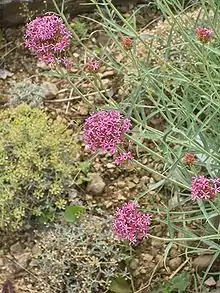Centranthus
Centranthus is a flowering plant genus comprising herbs and subshrubs native to Southern Europe. It is in the family Caprifoliaceae.[1] There are about twelve species in the genus.[2] Some Centranthus are known as introduced species in other parts of the world, including Centranthus ruber in the western United States[3] and Centranthus macrosiphon in Western Australia.[4]
| Centranthus | |
|---|---|
 | |
| Flowers of the narrow-leaved valerian (Centranthus angustifolius) | |
| Scientific classification | |
| Kingdom: | Plantae |
| Clade: | Tracheophytes |
| Clade: | Angiosperms |
| Clade: | Eudicots |
| Clade: | Asterids |
| Order: | Dipsacales |
| Family: | Caprifoliaceae |
| Subfamily: | Valerianoideae |
| Genus: | Centranthus Neck. ex Lam. & DC. |
| Species | |
|
see text | |
| Synonyms | |
|
Kentranthus Neck. | |
Centranthus is unusual in having flowers with "handedness", that is, having neither radial nor bilateral symmetry.[5]
Species include:[6]
- Centranthus amazonum Fridlender & A.Raynal [7]
- Centranthus angustifolius (Mill.) DC. [7] - narrow-leaved valerian
- Centranthus calcitrapae (L.) Dufr. [7]
- Centranthus kellereri Stoj., Stef. & T.Georgiev [8]
- Centranthus lecoqii Jord. [7]
- Centranthus longiflorus Steven [7]
- Centranthus macrosiphon Boiss. [7] - long-spurred valerian
- Centranthus nevadensis Boiss. [7]
- Centranthus ruber (L.) DC. [7] - red valerian
- Centranthus trinervis (Viv.) Bég. [7]
- Centranthus × aurigeranus Giraudias [7]
References
- "Centranthus", The Plant List (version 1.1), retrieved 2014-09-19
- Jepson Manual Treatment
- USDA Plants Profile
- "FloraBase Profile". Archived from the original on 2011-05-24. Retrieved 2009-02-25.
- Weberling, Focko (1992). Morphology of Flowers and Inflorescences. Cambridge University Press. p. 19. ISBN 0-521-25134-6.
- "Genus Centranthus". The Plant List. Retrieved 2 May 2013.
- Plants of the World online
- Tsymbalyuk, Zoya M.; Ivanova, Daniella; Nitsenko, Lyudmila M. (2021). "Taxonomic significance of palynomorphological characteristics of selected Centranthus (Caprifoliaceae) species". Hacquetia. 20 (2): 243–256. doi:10.2478/hacq-2021-0021.
This article is issued from Wikipedia. The text is licensed under Creative Commons - Attribution - Sharealike. Additional terms may apply for the media files.